Papers by Douglas C Worts

University of Calgary Press eBooks, Apr 29, 2005
This chapter explores the links between sustainability (in the Brundtland Commission’s sense), cu... more This chapter explores the links between sustainability (in the Brundtland Commission’s sense), culture, and the potential of museums as agents of social change. It is asserted that, while museums can and should be addressing sustainability through the non-formal education system, they also have a broader role to play as active facilitators of social change at local and regional levels. Museums can help by encouraging people to become more conscious of critical relationships that link them to nature and to other people. Some of the roles that museums can play include being storytellers through non-formal education providing sanctuaries that inspire reflection, and acting as catalysts to spark needed social change. Part of this article explores an exhibit, called "The Human Factor", which was developed at the Royal Saskatchewan Museum, in Regina, Canada, as an experiment in public engagement in issues related to our unsustainable world, and what can be done to change it.

Visitor Studies, 1989
Shaking the Foundations, Recent Audience Research at the Art Gallery of Ontario may sound quite d... more Shaking the Foundations, Recent Audience Research at the Art Gallery of Ontario may sound quite dramatic, and in many ways it is. However, in a highly conservative and change-resistant organization, such as an art museum, shaking foundations is not as hard to do as it might seem. It simply involves seeking answers to somc fairly obvious, but all too seldom asked, questions. A sampling of thcsc are: What do visitors to an art museum cxpcct from their visit? How do visitors react when they confront a room full of traditional landscape paintings; or a room full of Abstract Expressionist paintings; or an installation of Renaissance altarpieces? . Is anything of the "cultural significance" of our collections communicated through an art museum experience? Do "aesthetic experiences" really exist-and, if so, what are they? . Can anything be done to improve the quality of visitor experiences of an art museum?
Journal of Museum Education, Apr 1, 2006
Although museums are normally categorized as "cultural" organizations, they rarely plan their fou... more Although museums are normally categorized as "cultural" organizations, they rarely plan their foundational activities or judge the success of their public programming according to the cultural health and well being of their communities. A small group of educators, curators, and museologists in Canada has developed an assessment framework that aims to foster dialogue across the museum community on how museums can better address the cultural needs and opportunities of our time.
University of Calgary Press eBooks, Oct 10, 2018
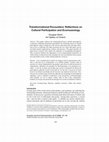
Canadian Journal of Communication, 2006
This paper explores the relationship between cultural participation, community wellbeing and glob... more This paper explores the relationship between cultural participation, community wellbeing and global sustainability. By reframing notions of cultural participation within a perspective that stresses interconnection and deep reflection as key to wellbeing, the author questions the core values that guide, govern and fund cultural organizations, policies and practices. The paper presents ten quasi-fictive scenarios that explore the dynamics of meaningful participation. They creatively illustrate the importance of an ecomuseological perspective in which culture is understood as the foundation for increased human consciousness and responsible action to share limited planetary resources. Résumé : Cette communication explore les rapports entre la participation culturelle, le bien-être de la communauté, et la viabilité globale. L'auteur remet en question les valeurs fondamentales qui guident, gouvernent et subventionnent les organisations culturelles, les principes de fonctionnement et les pratiques courantes. À cette fin, il utilise une tactique qui consiste à reformuler les notions de participation culturelle à partir d'un point de vue qui met l'accent sur les liens étroits et la réflexion profonde afin de favoriser une situation de bien-être. On y retrouve dix scénarios quasi fictifs qui explorent une dynamique de participation impliquée. Ceux-ci illustrent l'importance d'une perspective écomuséologique selon laquelle on voit la culture comme étant la base d'une connaissance humaine accrue qui nous permettra de partager des ressources planétaires limitées.
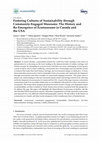
Sustainability, 2016
In recent decades, communities around the world have been reacting to the forces of globalization... more In recent decades, communities around the world have been reacting to the forces of globalization by re-focusing on the local, leading to the democratization of culture, heritage, and related concepts. By attempting to reconnect locals with their own sense of belonging, to reinvigorate a pride of place, and to foster wellbeing, communities have increasingly and successfully turned to features that make their local history, heritage, and environment unique or distinctive. In turn, democratization processes have led to sustainable forms of economic and community development through ecomuseums and other examples of community-engaged museums. This paper aims to deepen our understanding of relevant community-based culture and heritage initiatives by reflecting on the development of ecomuseums in Canada and the USA. As part of the larger museum community, ecomuseums tend to be accessible entities that are not affiliated with political or other convictions or viewpoints. This makes them uniquely positioned to foster creative change and adaptation aimed at sustainability, yet their evolution in North America has not been examined from this perspective. To address this gap, this paper will highlight the Haute-Beauce Ecomuseum in Québec and the Ak-Chin Him Dak Ecomuseum in Arizona, which have long histories as North American ecomuseums and represent two very different cultural and geographic contexts. We also reflect on the history of ecomuseums in Canada, and their recent emergence in the Canadian province of Saskatchewan.
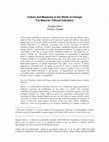
Culture and Local Governance, 2011
How individuals live their lives, within the context of personal and collective values, expresses... more How individuals live their lives, within the context of personal and collective values, expresses their living culture. Societies may be made up of people with different ethnocultural backgrounds, socio-economic profiles or spiritual orientations, but they share certain common cultural frameworks (e.g., democratic governance, rules of law, conventions of business, principles of equity for all, etc.) of what is increasingly a globalized, pluralized, and urbanized present. Culture is often thought of as either the historical traditions of a group, or else as certain types of activities (e.g., dance, theatre, celebrations, rituals, etc.) and objects (e.g., art, artifacts, clothing, etc.). Meanwhile, cultural organizations are characterized as specialized places of expertise that provide selected kinds of experiences and services to the public – normally available for consumption during leisure time. This article argues that the heart of living culture is to be found not in specialized ...
Journal of Museum Education, 2006
Abstract Although museums are normally categorized as “cultural” organizations, they rarely plan ... more Abstract Although museums are normally categorized as “cultural” organizations, they rarely plan their foundational activities or judge the success of their public programming according to the cultural health and well being of their communities. A small group of educators, curators, and museologists in Canada has developed an assessment framework that aims to foster dialogue across the museum community on how museums can better address the cultural needs and opportunities of our time.
Blog of the Coalition of Museums For Climate Justice, 2018
"How much energy is required to maintain temperature and humidity levels inside a museum? Because... more "How much energy is required to maintain temperature and humidity levels inside a museum? Because of the wide-ranging realities of museum environments, it is likely that no such aggregation of data has taken place. However, many individual museums have begun to ask penetrating questions about the carbon intensity of their operations. The links between environmental controls, energy and carbon emissions are both real and strong..." This article raises issues about the full costs to museums, society and the environment of operating as they have for a very long time. Not only do museums consume a huge amount of energy and produce a great deal of Greenhouse Gas Emissions, but the opportunity of costs of functioning in traditional ways may be very high as well.

International Journal of Environmental, Cultural, Economic and Social Sustainability, 2010
In this day and age, one thing seems increasingly clear, at least in industrialized countries. Hu... more In this day and age, one thing seems increasingly clear, at least in industrialized countries. Human beings have created cultures that are unsustainable. 1 From the uncertain implications of climate change, to the realities of a global economic melt-down and the growing gap between rich and poor, there are few indications that a human population of over 6.5 billion can continue to survive, let alone thrive, on planet Earth. As humanity proceeds down the path of globalization, pluralization and urbanization, there is a niggling question-can we create a global/local 'culture of sustainability'? If so, what might it look like? How do we move towards it? How do we know if we are getting closer, or drifting ever further from this goal? Culture, like sustainability, is a term that has come to mean different things to different people. Most would agree that history, art, language, food, music and clothing are all part of what we mean by the word 'culture'-especially when these attributes have a tradition that stretches back through the generations. Certain types of leisure-time organizations (like museums, galleries, theatres, etc) are commonly thought of as 'cultural'-because they specialize in selected aspects of human endeavour that are associated with culture (art, artifacts, music, dance, etc.). In our increasingly pluralistic world, culture is often linked to ethno-cultural countries of origin. Within all these approaches to culture, there is a tendency to point towards the past and 'the other', usually at the expense of seeing that culture envelops each of our communities, on a day-today basis. Culture may include traditions and the past, and it may even include trips to museums and other leisure-time edutainment organizations; however, first and foremost, culture is the living, changing dynamic of how we live our lives, individually and collectively, locally and globally, consciously and unconsciously. One of the hallmarks of the modern era has been the fragmenting of the world into areas of specialization. This technique has yielded huge rewards for humanity.
MUSE, 2008
An editorial that calls for museums to develop a robust set of indicators that will help identify... more An editorial that calls for museums to develop a robust set of indicators that will help identify the cultural issues of our day and enable us to better assess cultural outcomes/impacts.
MUSE, 2008
Version française de mon éditorial invité de 2008 dans le magazine MUSE sur les musées "Relever l... more Version française de mon éditorial invité de 2008 dans le magazine MUSE sur les musées "Relever le défi: favoriser une" culture du développement durable "".
MUSE , 1991
An early article on the work of the author as an educator, interpretive planner and audience rese... more An early article on the work of the author as an educator, interpretive planner and audience researcher at the Art Gallery of Ontario. Specifically, this article explores experimentation on the use of computers as tools for public engagement and interaction with artworks. This 1991 article, in MUSE (the Journal of the Canadian Museums Association) compiles experimental use of computers in exhibits, which began in 1985. The theme of this journal issue was "Museums in the Information Age: Crossing the Frontiers", and compiled several useful contributions on the use of technology in museums. (originally published in English and French - but only the English is provided here). Contact author for French version.
Museum Quarterly, 1984
An early example, within an art museum setting, of using experimental exhibition development proc... more An early example, within an art museum setting, of using experimental exhibition development processes that revolve around public education goals, accompanied by evaluation techniques. In 1984, the Education Division of the Art Gallery of Ontario (AGO) planned, mounted and evaluated an exhibit entitled "Attitudes: the Nude in Art". It was likely the first time that such an integrated approach to exhibit development and evaluation had been attempted at the AGO. Using the theme of 'the nude', this project raised many opportunities to engage the public both on the basis of objects/artworks and on issues. Many insights were gained along the way, at least by those involved in the project. This article was co-written with my colleague Kim Ness.
Museum Quarterly (The Journal of the Ontario Museum Association), 1986
A discussion of an old, but sometimes persistent, stereotype of museum volunteers, specifically i... more A discussion of an old, but sometimes persistent, stereotype of museum volunteers, specifically in relationship to the fuzzy notion of 'professionalism' within the often hierarchical world of museums. The paper shines a light on the two basic frames for assessing 'professionalism' - a) that a field is governed by clearly established values and goals, cultivated skill sets and command of a body of knowledge, as well as codes of conduct that are administered by the field itself; and b) a more informal ability to set clear goals and have the ability to deliver on those goals in a competent manner.
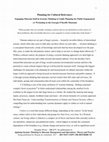
Systems Thinking in Museum: Theory and Practice, 2017
" When people who are actually creating a system start to see themselves as the source of their p... more " When people who are actually creating a system start to see themselves as the source of their problems, they invariably discover a new capacity to create results they truly desire. " i " Human endeavors are part of larger systems… bound by invisible fabrics of interrelated actions, which often take years to fully play out their effects on each other…. Systems thinking is a conceptual framework, a body of knowledge and tools that has been developed over the past fifty years, to make the full patterns clearer, and to help us see how to change them effectively. " ii Within a cultural context, the purpose of using a systems thinking approach is to shed light on interconnections between and within societal and natural spheres. Over the decades I have learned that museums are part of large social/economic/environmental systems and have the potential to create cultural impacts that go well beyond the museum itself. Amongst the biggest challenges for museums is the planning for and measurement of cultural outcomes within the larger world (as opposed to being focused on internal museum functions and public outputs). It is through systems thinking that museums can best realize their full value and relevance, for individuals, groups and communities that all must exist within the constraints of the biosphere. C.S Holling is one of the many architects of 'systems thinking'. Holling examined complex forest ecosystems iii to better understand relationships among the smallest levels (cellular) to the largest levels (the large forest as a whole). He studied the material and energy inputs, processes, outputs, feedback loops and more—all critical elements of a systems approach. His book Panarchy: Understanding Transformations in Human and Natural Systems, offers a compelling lens for understanding how systems dynamics apply to culture as well as natural settings. iv Culture is a word that means different things, depending on the context. v In the broad sense, culture refers to how individuals and groups live their lives, over time. In a Western context, our living culture is linked to a complex set of forces and factors that currently result in our pluralistic, urbanized, and globalized reality—which happen to include the systematic degradation of the biosphere (e.g. climate change and species loss), as well as significant social
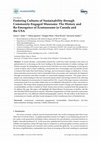
In recent decades, communities around the world have been reacting to the forces of globalization... more In recent decades, communities around the world have been reacting to the forces of globalization by re-focusing on the local, leading to the democratization of culture, heritage, and related concepts. By attempting to reconnect locals with their own sense of belonging, to reinvigorate a pride of place, and to foster wellbeing, communities have increasingly and successfully turned to features that make their local history, heritage, and environment unique or distinctive. In turn, democratization processes have led to sustainable forms of economic and community development through ecomuseums and other examples of community-engaged museums. This paper aims to deepen our understanding of relevant community-based culture and heritage initiatives by reflecting on the development of ecomuseums in Canada and the USA. As part of the larger museum community, ecomuseums tend to be accessible entities that are not affiliated with political or other convictions or viewpoints. This makes them uniquely positioned to foster creative change and adaptation aimed at sustainability, yet their evolution in North America has not been examined from this perspective. To address this gap, this paper will highlight the Haute-Beauce Ecomuseum in Québec and the Ak-Chin Him Dak Ecomuseum in Arizona, which have long histories as North American ecomuseums and represent two very different cultural and geographic contexts. We also reflect on the history of ecomuseums in Canada, and their recent emergence in the Canadian province of Saskatchewan.











Uploads
Papers by Douglas C Worts